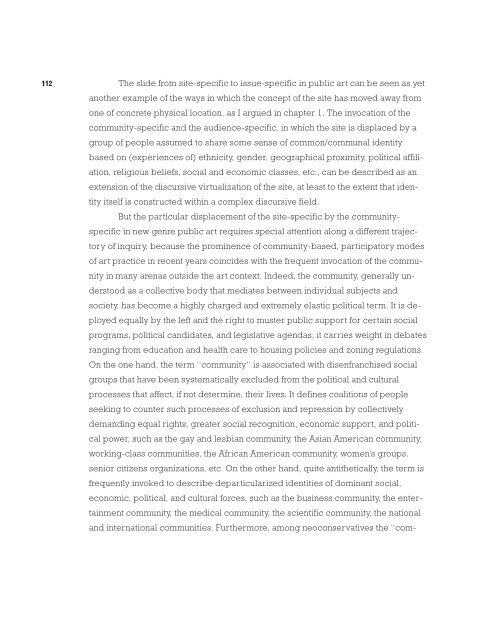ONE PLACE AFTER ANOTHER - Monoskop
ONE PLACE AFTER ANOTHER - Monoskop
ONE PLACE AFTER ANOTHER - Monoskop
Create successful ePaper yourself
Turn your PDF publications into a flip-book with our unique Google optimized e-Paper software.
112<br />
The slide from site-specific to issue-specific in public art can be seen as yet<br />
another example of the ways in which the concept of the site has moved away from<br />
one of concrete physical location, as I argued in chapter 1. The invocation of the<br />
community-specific and the audience-specific, in which the site is displaced by a<br />
group of people assumed to share some sense of common/communal identity<br />
based on (experiences of) ethnicity, gender, geographical proximity, political affiliation,<br />
religious beliefs, social and economic classes, etc., can be described as an<br />
extension of the discursive virtualization of the site, at least to the extent that identity<br />
itself is constructed within a complex discursive field.<br />
But the particular displacement of the site-specific by the communityspecific<br />
in new genre public art requires special attention along a different trajectory<br />
of inquiry, because the prominence of community-based, participatory modes<br />
of art practice in recent years coincides with the frequent invocation of the community<br />
in many arenas outside the art context. Indeed, the community, generally understood<br />
as a collective body that mediates between individual subjects and<br />
society, has become a highly charged and extremely elastic political term. It is deployed<br />
equally by the left and the right to muster public support for certain social<br />
programs, political candidates, and legislative agendas; it carries weight in debates<br />
ranging from education and health care to housing policies and zoning regulations.<br />
On the one hand, the term “community” is associated with disenfranchised social<br />
groups that have been systematically excluded from the political and cultural<br />
processes that affect, if not determine, their lives. It defines coalitions of people<br />
seeking to counter such processes of exclusion and repression by collectively<br />
demanding equal rights, greater social recognition, economic support, and political<br />
power, such as the gay and lesbian community, the Asian American community,<br />
working-class communities, the African American community, women’s groups,<br />
senior citizens organizations, etc. On the other hand, quite antithetically, the term is<br />
frequently invoked to describe departicularized identities of dominant social,<br />
economic, political, and cultural forces, such as the business community, the entertainment<br />
community, the medical community, the scientific community, the national<br />
and international communities. Furthermore, among neoconservatives the “com-

















